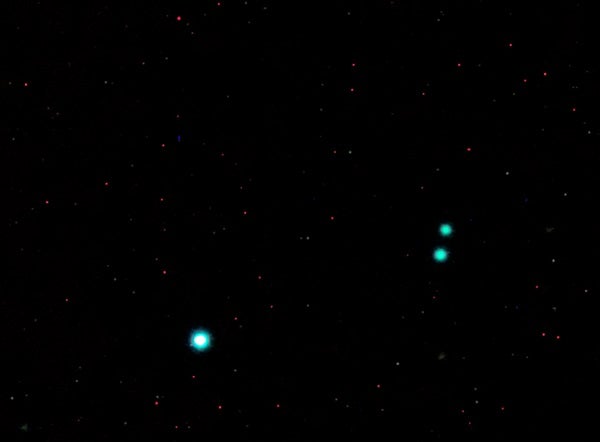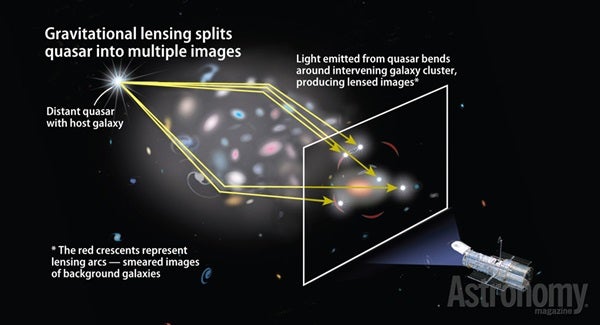Imagine you’re looking at your friend “Mike” and see two of him standing there. One is your friend now, and the other is Mike as he appeared more than a year earlier.
Could something like this really happen? Definitely! If you gaze at the Big Dipper when it’s highest, in the spring, you’ll see that it’s oriented upside down, as if any water in its bowl would spill downward onto the North Star. At this time, if you visually draw a line from the upper-right bowl star, Phad (Gamma [γ] Ursae Majoris), to the upper left one, Merak (Beta [β] Ursae Majoris), and then extend it an equal distance, you get to a blank bit of sky where large telescopes show a curious 17th-magnitude pair of dots. This is the Double Quasar, whose official name is the poetically lilting QSO 0957+561.

Bringing the universe to your door. We’re excited to announce Astronomy magazine’s new Space and Beyond subscription box – a quarterly adventure, curated with an astronomy-themed collection in every box. Learn More >>.
Quasars are the super-brilliant active nuclei within some galaxies. When the universe was younger, intense starbursts popped off in galactic centers as matter swirled around supermassive black holes, making their nuclei much brighter than the rest of the galaxy. When viewed from distances of billions of light-years, they show up as dazzling pinpoints while the rest of the galaxy remains invisible. Because they seem like quasi-stellar objects, they’re anagramized as quasars or QSOs.
Quasars don’t exist anywhere anymore. The ones we see now are ancient specimens whose light is still en route to us from distant empires. In the case of QSO 0957+561, the quasar is located 7.8 billion light-years away — a whopping two-thirds of the way to the edge of the observable universe. This alone makes it interesting.
Except that this quasar isn’t “one” object but seems to be a pair of them. Or is it? Astronomers using spectroscopy determined that both show precisely the same fingerprint. They are one and the same. A massive foreground galaxy, unseen in most QSO 0957+561 images, has bent space and forced the quasar’s light to take two separate routes to reach us. These individual light paths do not travel side by side, but manage to ride on highways routed on different sides of the foreground galaxy so that one traverses extra mileage. Thus, any flickering or change in one image of the quasar is followed by the same change in the other image 417 days later.
Albert Einstein’s general theory of relativity predicted such gravitational lensing — the bending of space — in 1915. It essentially means that light rays change direction when passing near a massive object. The positional shift of a star in Taurus during the 1919 total solar eclipse confirmed this theory. When the geometry is just right and the foreground-lensing object is huge, as when a major galaxy of hundreds of billions of stars is doing the warping, we might observe a ring, arcs, or multiple images of the same distant object as it travels to us past the intervening mass.
Double quasar 0957+561 was the first confirmed case of gravitational lensing. Astronomers found it after detecting intense radio sources in the sky. Because normal galaxies emit little radio energy, this sign of intriguing violent activity raised the possibility that the source could be a faraway quasar. Searching for such radio counterparts in 1979, astronomers saw a “double star” at the correct position, with their separation a scant 6 arcseconds — little more than the apparent width of Uranus. When both “stars” were seen to have identical spectra, including perfectly matching redshifts, astronomers knew the two were the same entity, broken into copies as in a funhouse mirror. Some of the world’s largest telescopes then stared at the spot and detected a massive elliptical galaxy, called YGKOW G1, almost directly in front of one of the quasar images. They also found a tightly packed cluster of surrounding galaxies that might add their gravity to the lensing effect.
In 1996, astronomer Rudolf Schild recorded a short-lived dip in the light from the brighter of the two quasar images and theorized that it was due to a planet weighing 3 Earth masses orbiting an unseen star in the foreground galaxy, briefly influencing the light. This is controversial and impossible to confirm because the accidental lineup that produced the flicker will never happen again in the life of the universe. Too bad. If it were true, it would be the farthest-ever planet in the cosmos.
So, getting back to QSO 0957+561, which is the actual quasar, the image at the top or the one at the bottom of the photo at the top of the page? And which is the echo, the phantom? The answer is: neither. They are both the same quasar.











